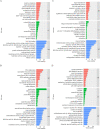Application of compound material alleviates saline and alkaline stress in cotton leaves through regulation of the transcriptome
- PMID: 33032521
- PMCID: PMC7542905
- DOI: 10.1186/s12870-020-02649-0
Application of compound material alleviates saline and alkaline stress in cotton leaves through regulation of the transcriptome
Abstract
Background: Soil salinization and alkalinization are the main factors that affect the agricultural productivity. Evaluating the persistence of the compound material applied in field soils is an important part of the regulation of the responses of cotton to saline and alkaline stresses.
Result: To determine the molecular effects of compound material on the cotton's responses to saline stress and alkaline stress, cotton was planted in the salinized soil (NaCl 8 g kg- 1) and alkalized soil (Na2CO3 8 g kg- 1) after application of the compound material, and ion content, physiological characteristics, and transcription of new cotton leaves at flowering and boll-forming stage were analyzed. The results showed that compared with saline stress, alkaline stress increased the contents of Na+, K+, SOD, and MDA in leaves. The application of the compound material reduced the content of Na+ but increased the K+/Na+ ratio, the activities of SOD, POD, and CAT, and REC. Transcriptome analysis revealed that after the application of the compound material, the Na+/H+ exchanger gene in cotton leaves was down-regulated, while the K+ transporter, K+ channel, and POD genes were up-regulated. Besides, the down-regulation of genes related to lignin synthesis in phenylalanine biosynthesis pathway had a close relationship with the ion content and physiological characteristics in leaves. The quantitative analysis with PCR proved the reliability of the results of RNA sequencing.
Conclusion: These findings suggest that the compound material alleviated saline stress and alkaline stress on cotton leaves by regulating candidate genes in key biological pathways, which improves our understanding of the molecular mechanism of the compound material regulating the responses of cotton to saline stress and alkaline stress.
Keywords: Alkalinization; Antioxidant; Compound material; K+/Na+ ratio; Lignin biosynthesis; Salinization.
Conflict of interest statement
The authors declare that they have no competing interests.
Figures






References
-
- Wang G, Zhu QG, Meng QW, Wu CA. Transcript profiling during salt stress of young cotton (Gossypium hirsutum) seedlings via solexa sequencing. Acta Physiol Plant. 2012;34(1):107–115. doi: 10.1007/s11738-011-0809-6. - DOI
MeSH terms
Substances
LinkOut - more resources
Full Text Sources
Miscellaneous

